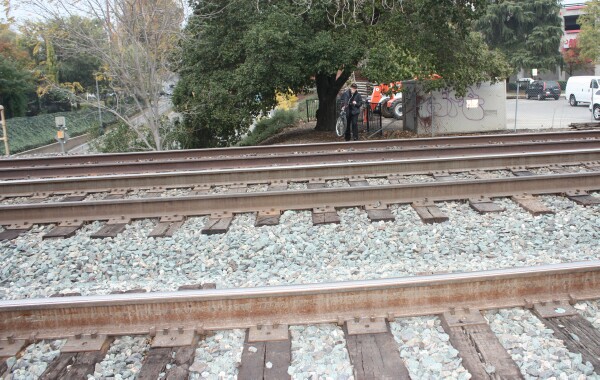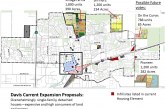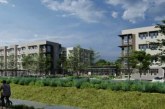 This issue of a proposed Union Pacific Railroad fence along Olive Drive has created a variety of rather complicated issues for the city. Residents of Olive Drive are concerned that a fence would cut them off from the heart of Davis.
This issue of a proposed Union Pacific Railroad fence along Olive Drive has created a variety of rather complicated issues for the city. Residents of Olive Drive are concerned that a fence would cut them off from the heart of Davis.
Others argue that the danger along that stretch of track is overstated and more attributable to reckless actions by individuals often intoxicated. A fence would greatly increase the distance people would have to walk or bike to get to certain locations in the city and thus might drive even more reckless behavior by some.
There will be presentations from several organizations including Union Pacific Railroad. While the city has no direct power, they have been working with the Capitol Corridor Joint Powers Authority (CCJPA), through council liaison Sue Greenwald.
Councilmember Greenwald has already expressed doubts as to whether the city has any ability to alter the dynamics of this proposal.
In a December 30 article in the Davis Enterprise, she reiterated that the city lacks any direct authority on this matter and that Union Pacific believes it has “a right to do this on their property.”
At the December 14 council meeting, after residents brought the matter to the attention of the council, Ms. Greenwald clarified that the JPA has no authority in terms of the fence, and that they can only decide whether or not to finance it for Union Pacific who owns the tracks and the right of way.
She told the council and public, “No, whether or not we participated or whether the JPA would give funds, the railroad was going to do it. The question is just how much control we would have and how much cooperation in making it somewhat nicer.”
She also said there was no possibility of an at-grade crossing. She said, “They said no. That’s not going to happen. For an at-grade crossing to happen, in the few occasions when they’ve allowed them it’s because they’ve managed to actually take away crossing not just at existing locations, but actually lead to a net reduction in the people that cross the tracks. That could not happen here.”
One thing the representative from Union Pacific did mention, according to Councilmember Greenwald, is that he would take a suggestion – a recommendation to his superior, and suggest that they put the fence as close as reasonable to the railroad tracks and perhaps consider allowing the city of Davis a right-of-way to allow a pedestrian-bike path that would hook up with the Lincoln Highway which takes you over to Harper Junior High and Pole Line Overcrossing. This has not been approved but it was something that they might consider.
“It looks like an exciting option that would help with the pedestrian and bike connections to the other side, Olive Drive,” Councilmember Greenwald said.
On Tuesday, staff recommends that the council direct staff to work with Union Pacific Railroad to address concerns about the fence including scope and design and report back to Council. Furthermore, they wish to explore options for utilizing Union Pacific Railroad right of way and city property to improve bicycle and pedestrian access to/from Olive Drive to the rest of the community and return to the City Council with a recommendation.
They recommend the staff to work with both Union Pacific Railroad and the Public Utilities Commission staff to explore crossing options and finally to direct Councilmember Greenwald to share with the Capitol Corridor Joint Powers Authority Board at their next meeting the City’s position as determined during the January 11, 2011 meeting.
How much influence the city can have is really difficult to determine, but it makes sense for the city to express a clear position and attempt to work with Union Pacific and CCJPA towards a more palatable solution.
Residents fear that they could be cut off from the most direct route into town.
Alan Miller, a local resident in Old East Davis residing near the tracks, has been one of the key organizers on this issue and has suggested while “the fence will cut down on the number of crossings, the legal alternative is less than ideal, and a certain number of individuals will circumvent the fence in dangerous and exotic ways. Realistically, the relative safety of as-yet-unbuilt solutions to this complex situation can be speculated on by those wishing to make a particular point, but [they] are not easily measured, and the points made by all involved parties are valid and should be considered as part of a ‘best scenario’ solution within available funding sources.”
Mr. Miller argued that more people have died at or very near legal crossings in and around Davis in the last few decades than have died adjacent to the proposed fence line.
At a rally in December, Mr. Miller told the crowd, “There is a problem, people cross these tracks and they do really stupid things. You have to do something,” he told the assembled crowd. “The problem is if you just put a wall up… people are going to go down to that end [pointing towards the Olive Drive freeway offramp] and cross the tracks in a more dangerous place or they’re going to walk across this bridge over Richards, so they walk along the tracks even more, or they’re going to cut a freakin’ hole in the fence in which case the whole thing is a waste of money anyway.”
“This isn’t the solution. What we need is a way over the top of the tracks,” Alan Miller said.
As Mr. Miller noted, it is questionable how much benefit this would give the safety aspect. Of all the deaths, he thinks perhaps only the one which involved a drunk employee of Murder [Redrum] Burger might have been prevented by having a wall. Many of the deaths are suicides and such individuals would simply avoid the stretch of track walled off on the south side, or would be able to enter the track from the north.
As Mr. Miller wrote in his op-ed in the Davis Enterprise, “Of the dozen person-vs.-train accidents in Davis proper over the past couple of decades, fewer than half were adjacent to the proposed fence, and only one or two might have been prevented by this fence. Most have been suicides, very intoxicated people, vehicle incidents, crimes or other random events. None that I can recall were happy sober persons crossing the tracks, who, like the proverbial chicken, simply wanted ‘to get to the other side.'”
However, not everyone agrees with Mr. Miller’s viewpoint.
Greg Kuperberg, a UC Davis Professor, has argued that the stretch of track running parallel to Olive Drive and Second Street represents the most dangerous half mile.
He wrote back in March, 2010, “It has been easy to overlook the problem for various reasons. At least one of these incidents was a suicide, and at least two cases were alcohol-related. But alcohol-related deaths are still preventable, and even many suicides are preventable according to the ‘opportunity theory’ of suicide.”
“The obvious solution is to fence the tracks, at least for the half mile stretch where these deaths occurred,” he writes. “We cannot fence all of the train tracks in the region, but according to opportunity theory, we aren’t obliged to do so. A few people may go to great lengths to get hit by a train, but most do not; usually people get hit by trains because it’s ‘convenient.’ The tracks along Olive Drive are particularly convenient and therefore particularly dangerous, because they are near streets and also at street level. However, just fencing the tracks is not enough.”
He continues, “There also needs to be a railroad crossing or a tunnel from Olive Drive to Second Street.”
Mayor Joe Krovoza and Mayor Pro Tem Rochelle Swanson expressed concerns at the December public event as well.
“Union Pacific has put us in a very difficult position,” Mayor Pro Tem Krovoza argued on Sunday, “Union Pacific has not supported an at-grade crossing here at the station. That’s the obvious thing to be done, and they haven’t done it.”
He said now they are turning around, trying to get public money to pay for a 3800-foot fence all along Olive Drive. He said that Union Pacific is pushing the problem onto the City of Davis to spend millions of money that is tight right now, when they have failed to offer their own solutions to the problem for years.
“How is UP going to solve this?” he asked rhetorically. “They are going to take public money that’s available from the State of California, they’re going to solve their liability problem and they are going to let the City of Davis spend millions to work around what they’ve decided to do.”
Mayor Krovoza agrees there is a problem, but he sees the problem as that of providing residents and children of South Davis a way to come to the downtown safely and effectively, to keep our downtown vital and get to school.
“Putting up this fence does not solve this problem,” he said. “Putting up this fence does not create a safer environment for the residents or these kids, because if they go to the West side as we’ve heard, they’re going to have to make four crossings through busy intersections which are absolutely less safe than walking across two train tracks where you can see everything coming.”
He added, “Or they can go to the east, and where’s the break going to be at the east? It’s going to be right at the Olive Drive offramp where you’ve got cars going 60 miles an hour coming across, that is less safe.”
Ultimately, the city has few options here, but they may be able to mitigate the impacts while looking towards future funding to get the kind of crossing that everyone appears to favor.
—David M. Greenwald reporting






Why not a community fundraising effort for a safe crossing?
We’re talking millions of dollars. They would have to find transportation grant money, which is fairly readily available.
That was my idea, grant plus community support. Seems like a topic Davis could get behind. Sorry if typos, microscopic on iPhone!
The problem that we face is that we have already applied for grant funding, and have not only been turned down, but have been told that the project has very low ranking. This is apparently due to the fact that we are competing with other projects in the region, and other similar projects serve far, far more people.
Perhaps there is some funding source that staff has not been able to locate, but so far it doesn’t look promising.